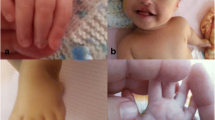Summary
Eight patients are reported with a de nov extra inverted duplicated chromosome 15. The abnormal chromosome was considered to be the same in all cases, but its precise delineation remained uncertain and was defined as either 15qter→15q12::15q12→15pter or 15pter→15q11::15q13→15pter. Analysis with various techniques of the satellite regions of the bisatellited chromosomes demonstrated maternal derivation in six and paternal derivation in one of the seven families. A nonsister chromatid exchange between the two homologous chromosomes 15 is considered a likely origin of the inv dup(15) in the cases with maternal derivation; in the only case of paternal derivation, however, the abnormal chromosome originated from one single chromosome 15. The clinical findings confirm that patients with inv dup(15) have mental and developmental retardation and are frequently affected by seizures, while severe physical malformations are absent.
Similar content being viewed by others
References
Eiberg H (1974) New selective technique for human chromosomes Cd staining. Nature 284:55
Fraccaro M, Zuffardi O, Bühler E (1979) Deficiencies involving the paracentromeric regions of chromosome 15: Prader-Willi or a new syndrome? In: Tolksdorf M, Spranger J (eds) Klinische Genetik in der Pädiatrie. Thieme, Stuttgart, pp 33–38
Fujita H, Sakamoto Y, Hamamoto Y (1980) An extra i dic(15p)(q11) chromosome in Prader-Willi syndrome. Hum Genet 55:409–411
Maraschio P, Zuffardi O, Lo Curto F (1980) Cd bands and centromeric function in dicentric chromosomes. Hum Genet 54:265–267
Power MM, Barry RG, Cannon DE, Masterson JG (1973) Familial partial trisomy 15. Ann Genet 16:271–275
Schreck RR, Breg WR, Erlanger BF, Miller OJ (1977) Preferential derivation of abnormal human G-group-like chromosomes from chromosome 15. Hum Genet 36:1–12
Schweizer D, Ambros P, Andrle M (1978) Modification of DAPI banding on human chromosomes by prestaining with DNA-binding oligopeptide antibiotic, distamycin A. Exp Cell Res 111:327–332
Van Dyke DL, Weiss L, Logan M, Pai GS (1977) The origin and behavior of two isodicentric bisatellited chromosomes. Am J Hum Genet 29:294–300
Wisniewski L, Hassold T, Heffelfinger J, Higgins JV (1979) Cytogenetic and clinical studies in five cases of inv dup (15). Hum Genet 50: 259–270
Wisniewski LP, Witt ME, Ginsberg-Fellner F, Wilner J, Desnick RJ (1980) Prader-Willi syndrome and bisatellited derivative of chromosome 15. Clin Genet 18:42–47
Author information
Authors and Affiliations
Rights and permissions
About this article
Cite this article
Maraschio, P., Zuffardi, O., Bernardi, F. et al. Preferential maternal derivation in inv dup(15). Hum Genet 57, 345–350 (1981). https://doi.org/10.1007/BF00281681
Received:
Revised:
Issue Date:
DOI: https://doi.org/10.1007/BF00281681




